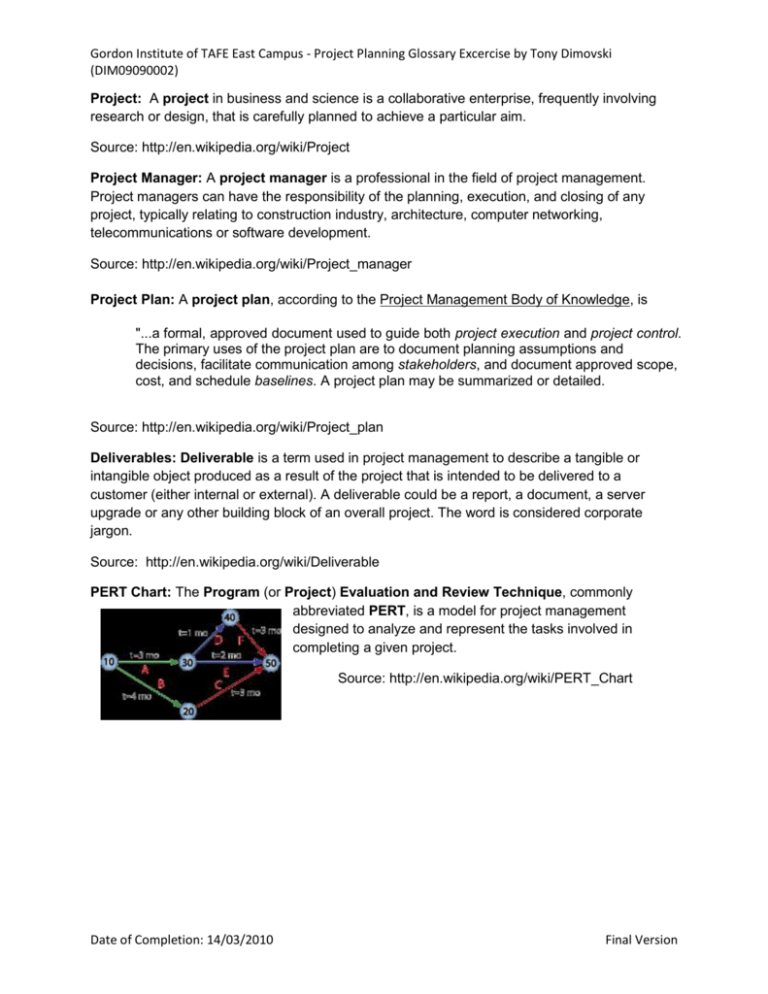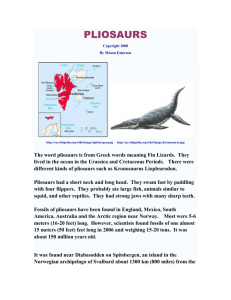Project Management Glossary Exercise
advertisement

Gordon Institute of TAFE East Campus - Project Planning Glossary Excercise by Tony Dimovski (DIM09090002) Project: A project in business and science is a collaborative enterprise, frequently involving research or design, that is carefully planned to achieve a particular aim. Source: http://en.wikipedia.org/wiki/Project Project Manager: A project manager is a professional in the field of project management. Project managers can have the responsibility of the planning, execution, and closing of any project, typically relating to construction industry, architecture, computer networking, telecommunications or software development. Source: http://en.wikipedia.org/wiki/Project_manager Project Plan: A project plan, according to the Project Management Body of Knowledge, is "...a formal, approved document used to guide both project execution and project control. The primary uses of the project plan are to document planning assumptions and decisions, facilitate communication among stakeholders, and document approved scope, cost, and schedule baselines. A project plan may be summarized or detailed. Source: http://en.wikipedia.org/wiki/Project_plan Deliverables: Deliverable is a term used in project management to describe a tangible or intangible object produced as a result of the project that is intended to be delivered to a customer (either internal or external). A deliverable could be a report, a document, a server upgrade or any other building block of an overall project. The word is considered corporate jargon. Source: http://en.wikipedia.org/wiki/Deliverable PERT Chart: The Program (or Project) Evaluation and Review Technique, commonly abbreviated PERT, is a model for project management designed to analyze and represent the tasks involved in completing a given project. Source: http://en.wikipedia.org/wiki/PERT_Chart Date of Completion: 14/03/2010 Final Version Gordon Institute of TAFE East Campus - Project Planning Glossary Excercise by Tony Dimovski (DIM09090002) GANTT Chart: A Gantt chart is a type of bar chart that illustrates a project schedule. Gantt charts illustrate the start and finish dates of the terminal elements and summary elements of a project. Source: http://en.wikipedia.org/wiki/Gantt_chart Project Resources: In project management terminology, resources are required to carry out the project tasks. They can be people, equipment, facilities, funding, or anything else capable of definition (usually other than labor) required for the completion of a project activity. Source: http://en.wikipedia.org/wiki/Resource_%28project_management%29 Project Stakeholder: Project stakeholders are those entities within or outside an organization which: a) Sponsor a project or, b) Have an interest or a gain upon a successful completion of a project. c) May have a positive or negative influence in the Project Completion. Examples of project stakeholders include the customer, the user group, the project manager, the development team, the testers, etc. Source: http://en.wikipedia.org/wiki/Project_stakeholder Project Life Cycle: Project management is the discipline of planning, organizing, and managing resources to bring about the successful completion of specific project goals and objectives. Source: http://en.wikipedia.org/wiki/Project_life_cycle#Project_development_stages Project Risk: Risk is defined in ISO 31000 as the effect of uncertainty on objectives (whether positive or negative). Source: http://en.wikipedia.org/wiki/Risk_management Date of Completion: 14/03/2010 Final Version Gordon Institute of TAFE East Campus - Project Planning Glossary Excercise by Tony Dimovski (DIM09090002) Project Risk Analysis: Risk analysis is a technique to identify and assess factors that may jeopardize the success of a project or achieving a goal. This technique also helps to define preventive measures to reduce the probability of these factors from occurring and identify countermeasures to successfully deal with these constraints when they develop to avert possible negative effects on the competitiveness of the company. Source: http://en.wikipedia.org/wiki/Risk_analysis_%28business%29 S.M.A.R.T. Goals: SMART / SMARTER is a mnemonic used in project management at the project objective setting stage. It is a way of evaluating the objectives or goals for an individual project. There is no clear consensus about precisely what the five + two keywords mean, or even what they are in any given situation. Typically accepted values are: Letter S M A R T E R Major Minor Terms Term Specific Significant, Stretching, Simple Measurable Meaningful, Motivational, Manageable Appropriate, Achievable, Agreed, Assignable, Actionable, Action-oriented, Attainable Ambitious Relevant Realistic, Results/Results-focused/Results-oriented, Resourced, Rewarding TimeTime-oriented, Time framed, Timed, Time-based, Timeboxed, Timely, Timebound Specific, Timetabled, Time limited, Trackable, Tangible Evaluate Ethical, Excitable Rewarded, Reassess, Revisit, Recorded Reevaluate Source: http://en.wikipedia.org/wiki/SMART_criteria Project Milestones: Within the framework of project management, a milestone is the end of a stage that marks the completion of a work package or phase, typically marked by a high level event such as completion, endorsement or signing of a deliverable, document or a high level review meeting. In addition to signaling the completion of a key deliverable, a milestone may also signify an important decision or the derivation of a critical piece of information, which outlines or affects the future of a project. In this sense, a milestone not only signifies distance traveled (key stages in a project) but also indicates direction of travel since key decisions made at milestones may alter the route through the project plan. Source: http://en.wikipedia.org/wiki/Milestone_%28project_management%29 Date of Completion: 14/03/2010 Final Version Gordon Institute of TAFE East Campus - Project Planning Glossary Excercise by Tony Dimovski (DIM09090002) Critical Success Factor: Critical Success Factor (CSF) is the term for an element that is necessary for an organization or project to achieve its mission. It is a critical factor or activity required for ensuring the success of your business. The term was initially used in the world of data analysis, and business analysis. For example, a CSF for a successful Information Technology (IT) project is user involvement. Factors: A plan should be implemented that considers a platform for growth and profits as well as takes into consideration the following critical success factors:[5] Money: positive cash flow, revenue growth, and profit margins. Your future: Acquiring new customers and/or distributors. Customer satisfaction: How happy they are. Quality: How good is your product and service? Product or service development: What's new that will increase business with existing customers and attract new ones? Intellectual capital: Create assets from the tools you make to run your business. Strategic relationships: New sources of business, products and outside revenue. Employee attraction and retention: Your ability to find, train, and keep employees and to let go employees that are not a good fit. Sustainability: Your personal ability to keep it all going. Source: http://en.wikipedia.org/wiki/Critical_success_factor Contingency: When estimating the cost for a project, product or other item or investment, there is always uncertainty as to precise content of all items in the estimate, how work will be performed, what work conditions will be like when the project is executed and so on. These uncertainties are risks to the project. Some refer to these risks as "known-unknowns" because the estimator is aware of them, and based on past experience, can even estimate their probable costs. The estimated costs of the known-unknowns is referred to by cost estimators as cost contingency. Source: http://en.wikipedia.org/wiki/Cost_contingency Intellectual Property: Intellectual property (IP) is a term referring to a number of distinct types of lergal monopolies over creations of the mind, both artistic and commercial, and the corresponding fields of law. Under intellectual property law, owners are granted certain exclusive rights to a variety of intangible assets, such as musical, literary, and artistic works; discoveries and inventions; and words, phrases, symbols, and designs. Common types of intellectual property include copyrights, trademarks, patents, industrial design rights and trade secrets in some jurisdictions. Source: http://en.wikipedia.org/wiki/Intellectual_property Date of Completion: 14/03/2010 Final Version Gordon Institute of TAFE East Campus - Project Planning Glossary Excercise by Tony Dimovski (DIM09090002) Progress Report: A Progress Report report of work accomplished during a specified time period. Source: http://www.google.com.au/search?hl=en&client=firefox-a&rls=org.mozilla%3AenUS%3Aofficial&channel=s&q=define%3A+progress+report&btnG=Search&meta= Quality Assurance: Quality assurance, or QA for short, refers to a program for the systematic monitoring and evaluation of the various aspects of a project, service, or facility to ensure that standards of quality are being met. Source: http://en.wikipedia.org/wiki/Quality_Assurance Final Report: A Final Report is an evaluation of the project results after the completion of a project. Some Final reports must also include financial tables. Source: http://www.google.com.au/search?client=firefox-a&rls=org.mozilla%3AenUS%3Aofficial&channel=s&hl=en&source=hp&q=define%3A+final+report&meta=&btnG=Google +Search Specifications: A specification is an explicit set of requirements to be satisfied by a material, product, or service. Should a material, product or service fail to meet one or more of the applicable specifications, it may be referred to as being out of specification; the abbreviation OOS may also be used. Source: http://en.wikipedia.org/wiki/Specifications Cost Estimation: Key objectives of cost engineering are to arrive at accurate cost estimates and to avoid cost overruns. The broad array of cost engineering topics represent the intersection of the fields of project management, business management, and engineering. Source: http://en.wikipedia.org/wiki/Cost_estimation Critical Activity: Critical Path: The sequence of dependent steps that determine the minimum time needed to carry out an operation. Source: http://www.google.com.au/search?hl=en&client=firefoxa&hs=EYi&rls=org.mozilla%3AenUS%3Aofficial&channel=s&q=define%3A+critical+path&btnG=Search&meta= Lag time: The amount of time delay between the completion of one task and the start of its successor task. Source: http://www.google.com.au/search?hl=en&client=firefox-a&rls=org.mozilla%3AenUS%3Aofficial&channel=s&q=define%3A+lag+time&btnG=Search&meta= Date of Completion: 14/03/2010 Final Version Gordon Institute of TAFE East Campus - Project Planning Glossary Excercise by Tony Dimovski (DIM09090002) Project Monitoring: Monitoring and controlling consists of those processes performed to observe project execution so that potential problems can be identified in a timely manner and corrective action can be taken, when necessary, to control the execution of the project. The key benefit is that project performance is observed and measured regularly to identify variances from the project management plan. Monitoring and Controlling includes: Measuring the ongoing project activities (where we are); Monitoring the project variables (cost, effort, scope, etc.) against the project management plan and the project performance baseline (where we should be); Identify corrective actions to address issues and risks properly (How can we get on track again); Influencing the factors that could circumvent integrated change control so only approved changes are implemented Source: http://en.wikipedia.org/wiki/Project_management#Monitoring_and_controlling Resource Planning: Enterprise resource planning (ERP) is an integrated computer-based system used to manage internal and external resources including tangible assets, financial resources, materials, and human resources. Source: http://en.wikipedia.org/wiki/Enterprise_resource_planning Date of Completion: 14/03/2010 Final Version




